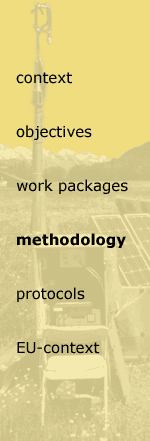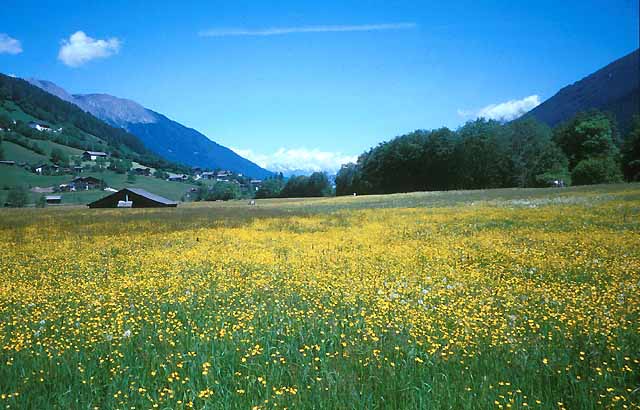

Methodology used to achieve the objectives
1. Quantification of the annual net ecosystem carbon exchange (NEE) and net biome production (NBP) in mountain ecosystems under different land use and climatic conditions
Within CARBOMONT, NEE will be measured directly and on a continuous basis within the frame of workpackage 1 (WP 1) by means of the Eddy Covariance (EC) method (Baldocchi et al. 1988), allowing the construction of annual sums of NEE. The methodologies and procedures (e.g. with regard to the standardisation of the EC method, calculation procedures, quality control of data and gap filling) developed within existing CO2 flux networks (Aubinet et al. 2000, Running et al. 1999, Valentini et al. 2000b, Falge et al. 2001) will be closely followed in order to grant maximum comparability to these. At sites where the assumptions underlying the EC method are violated, alternative techniques such as the Bowen-ratio-energy-balance (BREB) method and chamber techniques will be employed. The validity of these techniques will be assessed by careful cross-comparison with the EC method. In addition, process-oriented soil-vegetation-atmosphere-transfer (SVAT) models (WP 4), parameterised with site-specific data and validated against surface exchange measurements, will be used to estimate NEE during times when these alternative methods fail. The parameterised and validated SVAT models will provide also an alternative method of gap filling for annual carbon balance estimates (WP 1). Net biome production (NBP), which equals NEE minus off site carbon losses, will be estimated combining annual sums of NEE determined within the frame of WP 1 and estimates of the size of off site carbon losses, determined from harvesting and literature data (WP 2).
 |
2. Quantification of the contribution of the major ecosystem components to ecosystem carbon pools and fluxes, as affected by nitrogen availability
 In addition to the quantification of the NEE and NBP as detailed above, CARBOMONT aims at a quantification of the contributions of the major ecosystem components and a process analysis of the governing factors. Particular attention will be paid to effects of nitrogen availability, which may influence flux rates by altering tissue nitrogen concentrations and functional group composition. A combined experimental (WP 2 and 3) and modelling (WP 4) approach will be followed: WP 2 deals with the contribution of the major ecosystem components with regard to CO2 fluxes and the dependence of these processes on nitrogen contents and environmental driving forces. Recycling of respired CO2 and the partitioning of soil respiration into root and microbial components will be quantified using stable isotope techniques. Aim of WP 3 is to quantify ecosystem carbon and nitrogen pool sizes and their major components, to assess their seasonal and inter-annual variability, to derive from these an independent long-term estimate of the respective component fluxes, and to put component flux rates quantified in WP 2 in relation to the respective pool sizes. Another deliverable of WP 3 is the seasonal variation in hemi-surface plant area index, a fundamental input for ecosystem and landscape CO2 gas exchange modelling (WP 4 and 5). The objective of WP 4 is to integrate by means of process-oriented SVAT models the measurements made in WP 2 and 3 in order to carry out a detailed process analysis of the factors governing the contribution of the various ecosystem components to the NEE, their interactions and the way these are influenced by land use (Wohlfahrt et al. 2001).
In addition to the quantification of the NEE and NBP as detailed above, CARBOMONT aims at a quantification of the contributions of the major ecosystem components and a process analysis of the governing factors. Particular attention will be paid to effects of nitrogen availability, which may influence flux rates by altering tissue nitrogen concentrations and functional group composition. A combined experimental (WP 2 and 3) and modelling (WP 4) approach will be followed: WP 2 deals with the contribution of the major ecosystem components with regard to CO2 fluxes and the dependence of these processes on nitrogen contents and environmental driving forces. Recycling of respired CO2 and the partitioning of soil respiration into root and microbial components will be quantified using stable isotope techniques. Aim of WP 3 is to quantify ecosystem carbon and nitrogen pool sizes and their major components, to assess their seasonal and inter-annual variability, to derive from these an independent long-term estimate of the respective component fluxes, and to put component flux rates quantified in WP 2 in relation to the respective pool sizes. Another deliverable of WP 3 is the seasonal variation in hemi-surface plant area index, a fundamental input for ecosystem and landscape CO2 gas exchange modelling (WP 4 and 5). The objective of WP 4 is to integrate by means of process-oriented SVAT models the measurements made in WP 2 and 3 in order to carry out a detailed process analysis of the factors governing the contribution of the various ecosystem components to the NEE, their interactions and the way these are influenced by land use (Wohlfahrt et al. 2001).
3. Simulation analysis of likely future land-use scenarios on landscape NEE and NBP
The aim of WP 5 is to evaluate the annual carbon balances for landscape sections in order to estimate the effects of likely future land-use scenarios on landscape carbon sequestration. A GIS data base will be elaborated for the selected target landscapes, defining vegetation and soil parameters for each pixel. To obtain and/ or complement already existing spatial data sets a novel remote sensing technique will be tested and applied. As for the modelling approach, the one-dimensional SVAT model developed and parameterised in WP 4 will be integrated into a spatial framework that allows the landscape carbon balance to be derived from integration of the CO2 exchange of each pixel (Tenhunen 1999). Model parameterisation for forested landscape elements is supported by results from other EU and national projects (cf. Table 1). Scenarios of likely policy effects on land use will be defined by focus groups, comprising environmental scientists and local and regional stakeholders, which will be set up in each study site (WP 6). Effects of these land-use scenarios on landscape NEE and NBP will be simulated.
4. Spatial heterogeneity of ecosystem carbon fluxes, a new task of CARBOMONT contributed by NAS partners
The eddy covariance technique provides estimates of the net ecosystem exchange integrated for a certain area upwind of the instrument tower, which varies with wind direction and state of the atmosphere (Schmid 1994), making it difficult to attribute fluxes to a specific soil-vegetation type, in case the latter are not uniformly distributed. The aim of the new WP 7 is to directly quantify the contribution of different soil-vegetation types to the eddy covariance flux using a combination of chamber methods (Angell et al. 2001), a novel spatially explicit fluorescence imaging technique (Nedbal et al. 2000) and a footprint analysis (Baldocchi 1997), linking WP 1 and 2.
5. Dissemination and application of the information of the effects of different land-use scenarios on ecosystem and landscape carbon sequestration
Results of CARBOMONT will be made available to stakeholders at a local, regional, national and European level by a variety of ways (WP 6): GIS-based maps and spatial models developed in WP 5 will be made accessible to visualise the current and future effects of land use on ecosystem and landscape carbon sequestration. Different types of dissemination and education techniques will be used, including Internet, workshops and report-based recommendations to stakeholders. A link will be established with international programmes focussing on land-use changes and the carbon cycle (LUCC, IPCC, GCTE, ECCP). In order to promote a fast and effective application of the results of CARBOMONT in training, economy and administration, a close co-operation with the transfer and mobility programmes of the EU (SOCRATES, LEONARDO) will be implemented.
